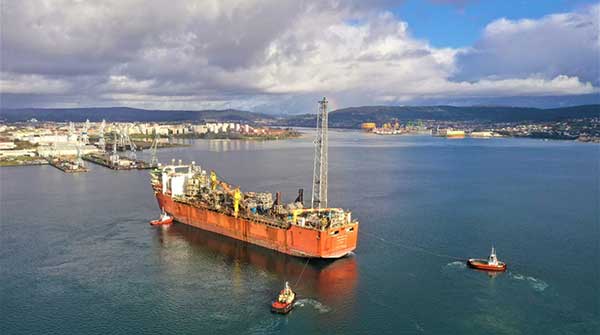A boost for Newfoundland economy and offshore oil industry
 The Terra Nova offshore oil project sits about 350 km southeast of St. John’s in the deep blue waters of the Atlantic.
The Terra Nova offshore oil project sits about 350 km southeast of St. John’s in the deep blue waters of the Atlantic.
And even though St. John’s Mayor Danny Breen can’t see the field and its massive floating, production, storage and offloading (FPSO) vessel from his office at city hall, he’s pleased it’s back to producing oil.
“There’s lots of numbers you could use to demonstrate Terra Nova’s contribution to our province and community, from the royalties and taxes it generates for governments or the jobs and contracts it provides to people and businesses,” says Breen.
“But it’s important for our psyche to see the FPSO back in production. To see it come back after some delays is great news for the province and the offshore industry.”
Suncor Energy CEO Rich Kruger announced in late November that Terra Nova’s FPSO vessel had restarted production after undergoing an extensive makeover in Spain to improve reliability and extend its life.
 The Terra Nova floating production, storage and offloading (FPSO) vessel. |
| Related Stories |
| Oil and gas Canada’s richest natural resource
|
| The high cost of interprovincial trade restrictions in Canada
|
| Controversy erupts as Canada proposes emissions cap for oil and gas industry
|
The massive vessel – standing 18 stories high and three football fields long – first started operating in 2002 and has produced more than 425 million barrels of oil, or enough to meet world oil demand at current levels for just over four days.
While the FPSO was in Spain, additional subsea work took place in the middle of the Atlantic to extend the Terra Nova field’s life, including replacing two million kilograms of mooring chain that anchors the ship to the underwater drilling system.
The project is forecast to extend the life of the Terra Nova project by 10 years and produce an additional 70 million barrels.
Phil Skolnick, Eight Capital’s managing director of research, sees Europe and Asia as potential destinations for those barrels when the project ramps up to full production.
Asian oil demand is rising, and Europe is now taking higher volumes of oil imports from countries other than Russia, its primary supplier before the start of the war in Ukraine.
“You should see it start to make a real impact on the market by 2025, when Terra Nova is expected to get back to producing 180,000 barrels per day,” he says.
“It will have a big impact for the Newfoundland economy.”
Even when the FPSO was in drydock in Spain, Terra Nova continued to provide benefits to the community at home.
In the third quarter of 2023, the latest period available, the project reported it spent $173.8 million in operational and capital expenditures.
This included $52.2 million in procuring goods and services, with 62 percent spent with suppliers in the province and 94 percent with Canadian vendors.
Terra Nova provides 710 direct jobs, with 90 percent of its workforce residing in Newfoundland and Labrador. The project is a partnership operated by Suncor, which holds a 48 percent stake. The other partners are Cenovus Energy (34 percent) and Murphy Oil (18 percent).
While wind, hydrogen and other energy projects have been proposed in Newfoundland and Labrador, Breen sees the offshore oil industry as a crucial part of the province’s economy now and in the future.
He believes Terra Nova and the other three producing oil fields in the province – Hibernia, Hebron and White Rose – will assume added importance for the local economy and global energy security.
“Oil is going to be around for a long time, even if demand decreases, because it is an essential part of so many products we use today. And that’s important for us because the offshore industry supports many families across Newfoundland and Labrador today,” Breen says.
“The industry has been under a lot of scrutiny and has faced a lot of challenges, particularly in the approval for new projects. Keeping the production from approved supplies is going to be vital. That’s why it’s good to see the investment in Terra Nova and the return to production. That bodes well for the future.”
Will Gibson is the Principal with Will Gibson Consulting Limited in Edmonton, Alta. This article was provided by the Canadian Energy Centre, a Troy Media Editorial Content Provider Partner.
For interview requests, click here.
The opinions expressed by our columnists and contributors are theirs alone and do not inherently or expressly reflect the views of our publication.
© Troy Media
Troy Media is an editorial content provider to media outlets and its own hosted community news outlets across Canada.


Interesting article but in paragraph six where it says the 425 million barrels of oil produced to the FPSO since 2002 is equivalent to just over four years of global oil demand, I believe that should be just over four days of global oil demand. This is based on global consumption of approximately 100, million barrels per day.
Thank you Don.
We have updated the article.
Great catch!
Interesting article but in paragraph six where it says the 425 million barrels of oil produced to the FPSO since 2002 is equivalent to just over four years of global oil demand, I believe that should be just over four days of global oil demand. This is based on global consumption of approximately 100, million barrels per day.
Interesting article but in paragraph six where it says the 425 million barrels of oil produced to the FPSO since 2002 is equivalent to just over four years of global oil demand, I believe that should be just over four days of global oil demand. This is based on global consumption of approximately 100, million barrels per day.